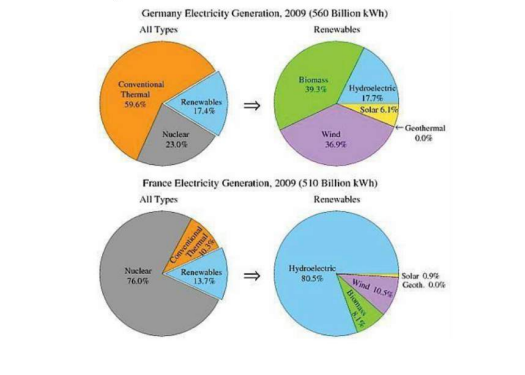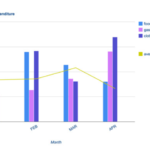The four pie charts compare the electricity generated between Germany and France during
2009, and it is measured in billions kWh. Overall, it can be seen that conventional thermal
was the main source of electricity in Germany, whereas nuclear was the main source in
France.
The bulk of electricity in Germany, whose total output was 560 billion kWh, came from
conventional thermal, at 59.6%. In France, the total output was lower, at 510 billion kWh,
and in contrast to Germany, conventional thermal accounted for just 10.3%, with most
electricity coming from nuclear power (76%). In Germany, the proportion of nuclear
power generated electricity was only one fifth of the total.
Moving on to renewables, this accounted for quite similar proportions for both countries, at
approximately 15% of the total electricity generated. In detail, in Germany, most of the
renewables consisted of wind and biomass, totaling around 75%, which was far higher than
for hydroelectric (17.7%) and solar (6.1%). The situation was very different in France,
where hydroelectric made up 80.5% of renewable electricity, with biomass, wind and solar
making up the remaining 20%.
(Words 183)
Estimated IELTS Band Score: 7.5 – 8.0
- Task Achievement (7.5): Clearly describes major features and draws comparisons. Could include some finer numerical details.
- Coherence & Cohesion (8.0): Well-structured with logical transitions.
- Lexical Resource (7.5): Good range of vocabulary, minor potential for more variety.
- Grammar & Accuracy (7.5): Mostly accurate; some room for more complex sentence structures.
Rewritten Essays
Band 8
The four pie charts illustrate the total electricity generation in Germany (560 billion kWh) and France (510 billion kWh) in 2009, along with a breakdown of each country’s renewable sources. Overall, Germany relied primarily on conventional thermal power, whereas France depended mostly on nuclear energy.
Conventional thermal accounted for 59.6% of Germany’s electricity, with nuclear making up 23%. Renewables represented 17.4%, consisting mainly of biomass (39.3% of renewables), wind (36.9%), and hydroelectric (17.7%), while solar was 6.1% and geothermal negligible. By contrast, France generated just 10.3% of its electricity from conventional thermal, relying heavily on nuclear power at 76%. Renewables took up 13.7%, dominated by hydroelectric at 80.5%, followed by wind (10.5%), solar (0.9%), and geothermal (0%).
In both countries, renewables comprised roughly 15% of total electricity output, but the composition varied significantly. Germany’s renewable mix favored biomass and wind, while France’s was overwhelmingly hydroelectric.
Word Count: 165
Band 9
The four pie charts compare the electricity generated in 2009 by Germany (560 billion kWh) and France (510 billion kWh), distinguishing between overall sources and renewables. Notably, Germany’s primary energy source was conventional thermal, whereas France depended heavily on nuclear power.
In Germany, 59.6% of electricity came from conventional thermal, with nuclear accounting for just 23%. Renewables represented 17.4%, of which biomass (39.3%) and wind (36.9%) were the main contributors, trailed by hydroelectric (17.7%) and solar (6.1%). Geothermal was negligible. Conversely, France’s reliance on nuclear power stood at a dominant 76%, while conventional thermal made up only 10.3%. Renewables formed 13.7% of total output, with hydroelectric dominating at 80.5%, followed by wind (10.5%), solar (0.9%), and geothermal (0%).
Despite renewables accounting for around 15% of total electricity in both nations, the composition of those renewables differed substantially. Germany’s green energy profile leaned toward biomass and wind, whereas France relied almost exclusively on hydroelectric.
Word Count: 169
Comparison Table
| Aspect | Band 7-8 Version | Band 9 Version |
|---|---|---|
| Vocabulary | Clear, uses “accounted for,” “relied on,” “dominated” | More precise, e.g., “composition varied significantly,” “trailed by,” “stood at” |
| Sentence Structure | Mostly straightforward with some complex sentences | More varied, with subordinate clauses and smooth transitions |
| Data Presentation | Covers key figures (percentages) and references main differences | Emphasizes major contrasts, highlights relative contributions of each renewable source |
| Clarity & Cohesion | Logical flow and paragraphing | Slightly more polished transitions, concluding statements more succinct |
Examples from Essays
| Aspect | Band 7-8 Example | Band 9 Example |
|---|---|---|
| Sentence Structure | “Conventional thermal accounted for 59.6% of Germany’s electricity, with nuclear making up 23%.” | “In Germany, 59.6% of electricity came from conventional thermal, with nuclear accounting for just 23%.” |
| Data Presentation | “Renewables represented 17.4% in Germany, consisting mainly of biomass and wind, while hydroelectric and solar were smaller.” | “Renewables formed 13.7% of total output in France, with hydroelectric dominating at 80.5%, followed by wind, solar, and geothermal.” |
| Clarity & Cohesion | “Both countries generated about 15% of their electricity from renewables, though the specific composition varied significantly.” | “Despite renewables accounting for around 15% of total electricity in both nations, the composition of those renewables differed substantially.” |
Grammar Mistakes
- Original: “Conventional thermal was the main source of electricity in Germany, while nuclear power accounted for most of Frances output.”
Correction: “Conventional thermal was the main source of electricity in Germany, while nuclear power accounted for most of France’s output.” (Apostrophe for possession.) - Original: “In France, 10.3% of electricity came from conventional thermal, while 76% was nuclear, and 13.7% from renewables.”
Correction: “In France, 10.3% of electricity came from conventional thermal, 76% from nuclear, and 13.7% from renewables.” (Parallel structure fix.) - Original: “Germany’s renewables were mostly biomass, wind, and hydroelectric, with solar being 6.1%.”
Correction: “Germany’s renewables consisted mostly of biomass, wind, and hydroelectric, while solar contributed 6.1%.” (More varied phrasing.)
Vocabulary Repetition
| Repeated Word | Suggested Alternatives |
|---|---|
| “Main” | Primary, Principal, Dominant |
| “Source” | Supply, Provider, Origin of electricity |
| “Represented” | Accounted for, Made up, Comprised |
IELTS Writing Task 1 Exercises with Answers
Fill in the blanks using the words below:
(dominated, negligible, accounted for, contrast, reliant, composition)
- In 2009, Germany was primarily _______ on conventional thermal energy, which _______ 59.6% of its total electricity.
Answer: reliant, accounted for - By ______, France generated only 10.3% from conventional thermal but 76% from nuclear.
Answer: contrast - Renewables made up around 17.4% in Germany, with solar being a relatively _______ share of just 6.1%.
Answer: negligible - The _______ of renewables in France was heavily skewed toward hydroelectric, which _______ 80.5% of green energy.
Answer: composition, dominated

